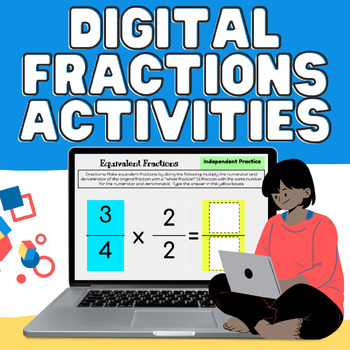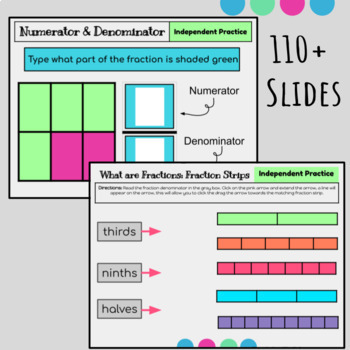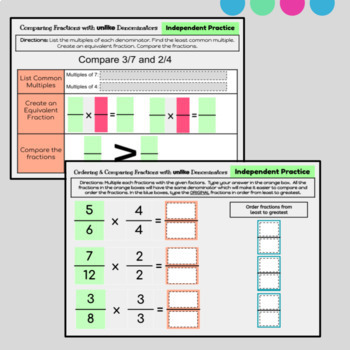Digital Fractions Unit: Equivalent Fractions, Comparing & Ordering Fractions
Enhance SEL
569 Followers
Resource Type
Standards
CCSS3.NF.A.3
CCSS3.NF.A.3a
CCSS3.NF.A.3b
CCSS3.NF.A.3d
CCSS4.NF.A.1
Formats Included
- Google Slides™
- Internet Activities
Pages
200 pages
Enhance SEL
569 Followers

Made for Google Drive™
This resource can be used by students on Google Drive or Google Classroom. To access this resource, you’ll need to allow TPT to add it to your Google Drive. See our FAQ and Privacy Policy for more information.
Description
Engage Your Students with an Interactive Digital Fractions Unit
Explore this versatile digital resource, compatible with Google Slides, Google Classroom Assignments, Google Drive, PowerPoint, and other digital platforms.
Unlock a wealth of usage possibilities:
- Utilize for guided, partner, or independent practice
- Ideal for morning work, small group reteaching, or review sessions
- Assign as homework or incorporate into math centers
Preview the entire resource to see its potential!
Students will tackle concepts such as:
- Understanding fractions
- Identifying numerators and denominators
- Using fraction strips for conceptualization
- Finding equivalent fractions
- Comparing fractions (greater than, less than, or equal to)
- Ordering fractions from least to greatest or vice versa
Each topic features:
- Guided and independent practice
- Word problem exercises
- Informative side notes
- Virtual posters for enhanced learning experiences"
This digital fractions unit aligns with several Common Core Math Standards, including:
- CCSS.Math.Content.3.NF.A.1: Understand a fraction 1/b as the quantity formed by 1 part when a whole is partitioned into b equal parts; understand a fraction a/b as the quantity formed by a parts of size 1/b.
- CCSS.Math.Content.3.NF.A.3: Explain equivalence of fractions in special cases, and compare fractions by reasoning about their size.
- CCSS.Math.Content.4.NF.A.1: Explain why a fraction a/b is equivalent to a fraction (n × a)/(n × b) by using visual fraction models, with attention to how the number and size of the parts differ even though the two fractions themselves are the same size.
- CCSS.Math.Content.4.NF.A.2: Compare two fractions with different numerators and different denominators, e.g., by creating common denominators or numerators, or by comparing to a benchmark fraction such as 1/2. Recognize that comparisons are valid only when the two fractions refer to the same whole. Record the results of comparisons with symbols >, =, or <, and justify the conclusions, e.g., by using a visual fraction model.
- CCSS.Math.Content.4.NF.B.3: Understand a fraction a/b with a > 1 as a sum of fractions 1/b.
Check out the previews for these awesome Digital Resources!
Total Pages
200 pages
Answer Key
Does not apply
Teaching Duration
1 month
Report this resource to TPT
Reported resources will be reviewed by our team. Report this resource to let us know if this resource violates TPT’s content guidelines.
Standards
to see state-specific standards (only available in the US).
CCSS3.NF.A.3
Explain equivalence of fractions in special cases, and compare fractions by reasoning about their size.
CCSS3.NF.A.3a
Understand two fractions as equivalent (equal) if they are the same size, or the same point on a number line.
CCSS3.NF.A.3b
Recognize and generate simple equivalent fractions, (e.g., 1/2 = 2/4, 4/6 = 2/3). Explain why the fractions are equivalent, e.g., by using a visual fraction model.
CCSS3.NF.A.3d
Compare two fractions with the same numerator or the same denominator by reasoning about their size. Recognize that comparisons are valid only when the two fractions refer to the same whole. Record the results of comparisons with the symbols >, =, or <, and justify the conclusions, e.g., by using a visual fraction model.
CCSS4.NF.A.1
Explain why a fraction 𝘢/𝘣 is equivalent to a fraction (𝘯 × 𝘢)/(𝘯 × 𝘣) by using visual fraction models, with attention to how the number and size of the parts differ even though the two fractions themselves are the same size. Use this principle to recognize and generate equivalent fractions.





